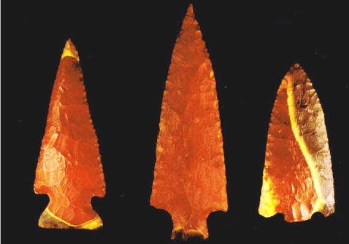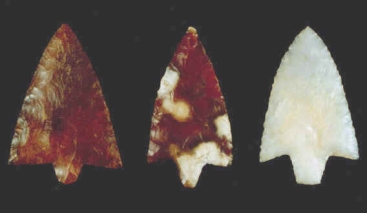Horse Creek chert is among the most beautiful flint types ever used by Native
Americans. This red, yellow, and blue-gray chert is found sparingly on a few hill tops in south-central Tennessee
and northern Mississippi. Probably a higher iron content in this chert than in other chert types causes the dramatic
bright colors. When nodules are found, they are gray or brownish-gray in color on the exterior. When cracked open,
the center of the nodule is brilliant red to red-orange surrounded by a yellow to yellow-white layer and finally
the blue-gray exterior. This tri-colored chert is slightly heavier than other cherts and is very tough to work.
It is sometimes referred to as Pickwick tricolor or Lost Quarry flint. Artifacts made from this material are found
primarily along the Tennessee River Valley drainage area of northern Alabama, northern Mississippi, and southern
Tennessee, though a few examples have been found as far away as Missouri. This material was used by all the Native
American cultural periods from Paleo through Mississippian. There are nine fluted pieces made from Horse Creek
chert known to this writer.
Early Native Americans occasionally heat treated this chert. Heat treating causes the
red to turn a burgundy or slightly purple color. The yellow bands turn to a yellow-orange, and the blue-gray sections
darken-slightly. The surface also becomes more lustrous when heat treated. This information was gained through
personal |

Artifacts made from Horse Creek chert from the collection of Charles E. Moore. Photo by Tony Clinton.
|
|

Left: Hillsborough point found in Putnum County, Florida. Center: Hillsborough
point from Dade County, Florida. Right: Hernado point found in Madison County, Florida. From the
collection of David Abbott. Photo by Tony Clinton.
|
experimentation. The same molecular changes occurred when I heat treated several large flakes
for 48 hours in a glowing charcoal fire.
As a personal project I am trying to establish how widely Horse Creek chert has
spread and been distributed from its original source. I would be most appreciative of information from anyone as
to where artifacts of this material have been found. This might establish trade and travel routes, as well as large
game migration patterns throughout the different cultural periods. My address is: Charles E. Moore, P.O. Box 894,
Florence, Alabama 35631.
The accompanying photograph demonstrates the use of this material during the Archaic and Woodland
Periods in the Southeastern United States. The point on the left is a resharpened Lost Lake point dating from the
Early Archaic Period (7000 to 5000 B.C.). It was found by a Mr. Gray while he was quail hunting in Alcorn County,
just north of Corinth, Mississippi. It is 3 1/4 inches long. The point in the center is a Little Bear Creek point
and was found by James Thorn, of Muscle Shoals, Alabama, in 1996. He found the point in Lauderdale County, Alabama.
This point is 4 inches long and dates from the Late Archaic to Late Woodland Periods (2000 B.C. to 500 A.D.). The
Eva point was found by this writer in Lauderdale County, Alabama, around 1980. It is 2 3/4 inches in length. It
dates from the Early to Middle Archaic Periods (5000 to 3000 B.C.).
|




